On Saturday, in the story  OpenSim grids still adapting to mesh, a couple of folks mentioned that OpenSim offers some advantages over Second Life when it comes mesh.
According to OpenSim core developer Melanie Thielker, it’s about more than just not having to pay upload fees.
“In Second Life, mesh to prim equivalency is calculated by land impact, the metric that has replaced prim count in Second Life,” said Thielker, who is also the founder of the Avination grid and president of OpenSim hosting company 3D Hosting.
In OpenSim, the calculation is done differently, with each submesh counted as a single prim, she told Hypergrid Business. So, for example, a mesh with a Second Life land impact of 45 can have a prim count of three in OpenSim.
“This makes it much easier to construct complex mesh models in OpenSim,” she said.
In addition, mesh objects in OpenSim could also have a lower prim count than similar prim-based objects.
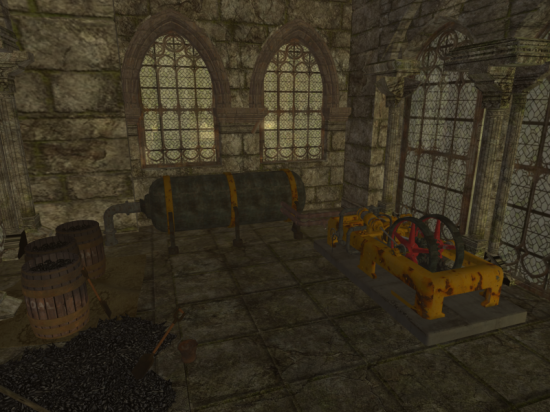
Total prim numbers matter in OpenSim because many hosting companies and grid owners set limits on the total numbers of prims allowed per region.
Total prims also matter because the more stuff there is on a region, the longer it takes for a viewer to show everything.

Here, mesh also offers some advantages over traditional prim building, Thielker said.
In order to display a prim object, viewers first convert them to mesh, she said.
“However, these meshes are not as optimized as a real, user-created mesh can be, and therefore a build made from prims can be less effficient than a build made from mesh,” she said. “Moreover, prim builds will have a lot of hidden surfaces, that is, prim surfaces that are wholly inside the build and will never be seen. On prim builds, the viewer has the task of identifying and removing these surfaces from view. That is additional computational load that mesh avoids.”
Second Life meshes are superior to OpenSim meshes in the way they deal with collision testing, however.
It’s easy for a physics engine to calculate whether someone has walked into a solid sphere or ball. It’s trickier to figure out if someone has walked through the center of a donut, however, or a doorway opening or another hollowed-out object.
“The calculations for such collisions can be quite complex,” Thielker said.
The solution is a process known as convex decomposition. A doorway, for example, can be looked at as three separate parts — the two sides and the top. These three separate parts are solid objects, without any hollows, and collision testing is easier.
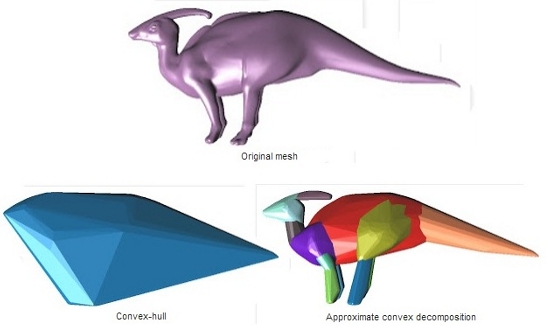
Today, the only grid other than Second Life that does convex decomposition is Avination, Thielker said.
That may change with the arrival of a new physics engine, BulletSim, which internally converts all physical shapes to convex hulls for performance, using an algorithm developed by Khaled Mamou. BulletSim is still under development by Intel.
In addition, InWorldz already uses complex decomposition for prim-based objects, and will have it for mesh as well, according to InWorldz CTO David Daeschler. InWorldz and Avination are the two most popular commercial grids and seem to be in a technological arms race with one another. Unlike the nuclear arms race, however, this particular arms race is one that benefits users.
According to Thielker, mesh is popular on Avination for buildings, vehicles, clothing, hair and avatar bodies.
One reason? Most users have a mesh-enabled viewer.
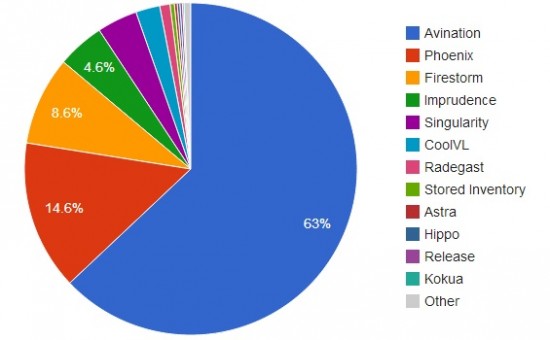
According to Avination server log data from the past six months, fewer than 6 percent of visits to the grid were with a non-mesh viewer such as Imprudence. Avination’s own official viewer displays mesh, and next release will support mesh uploads as well. Meanwhile, Firestorm both displays and uploads mesh.
Mesh-based transport
MOSES – Military Open Simulator Enterprise Strategy — is an OpenSim-based world run by the U.S. Army Simulation and Training Technology Center. But the army also uses other virtual environments as well, such as those built on top of the Unreal 3 engine, Unity 3D, and CryEngine.
“Mesh modeling has been a tremendous cost saver for us, as it allows us to reuse models previously created for other platforms,” said Douglas Maxwell, the center’s science and technology manager.
In the past, the Army would hire contractors to build “levels” — complete virtual environments. A new project, or a new platform, required starting from scratch. Working in OpenSim, in particular, required rebuilding until mesh support was added.
Today, Douglas said, the goal is to buy the underlying source material, so that the Army isn’t paying for the same truck over and over and over again.
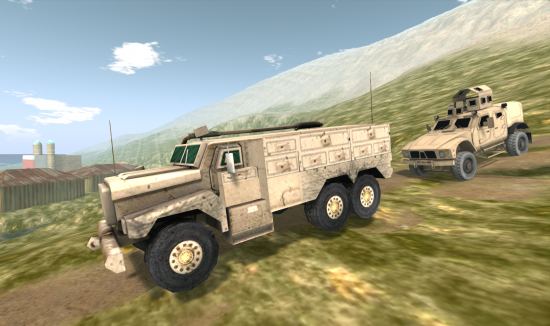
“We strive to reuse as much content as possible from previous projects, as well as use content from open sources,” he told Hypergrid Business. “We attempt to use our precious development dollars for specialized items only.”
Some of these mesh objects are available to the public, as a free download from the Defense Department’s Advanced Distributed Learning 3D Depository, where all the content is Creative Commons licensed. And it’s not all tanks and warplanes — the depository also includes some general-use items, like furniture, appliances, and this toilet.
Mesh is for artists
The open, non-profit Craft grid is based in Italy, so it’s no surprise that it’s home to a number of artists. The grid, which allows people to connect home-based regions, has been mesh enabled since OpenSim first added first support two years ago. The grid itself celebrated its third birthday this January.
“In the last annual building competition for our anniversary, the best works presented were mesh,” said grid manager Raffaele Macis, also known as Licu Rau in-world.
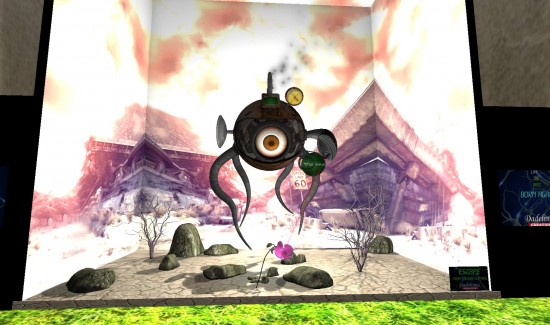
The exhibits are still up, and can be visited on the Suq region of Craft, accessible via hypergrid teleport at craft-world.org:8002:suq.

About 80 percent of Craft’s active residents use mesh-enabled viewers, Macis told Hypergrid Business, particularly Singularity and Firestorm.
Some still prefer to use Imprudence, however, he said. For example, teachers visiting from Florence University’s Edmondo educational grid use Imprudence on their grid, and tend to use Imprudence on Craft as well.
In addition, some users have older computers that work better with the older viewers, he said.
The most notable prim builder in Craft is Lumiere Noir, known for Second Life’s Ivory Tower. Noir is now building an Ivory Tower on Craft, Macis said, also using prims.
For Beta Technologies, mesh is the future
In the past, Beta Technologies, a virtual worlds consulting firm, has mostly worked with prim-based builds on its company grid, and on its client-facing regions in Kitely. Both Kitely and the Beta grid are mesh-enabled, however, and Beta designers are now busy learning how to use 3D modeling tools.
“All the users on the private grid use mesh-supporting viewers, and, indeed, mesh development is a significant portion of the activity,” said company owner Jeff Bush. “There’s no question about mesh being the future visual content tool in OpenSim, since it brings the front line 3D modeling into our Second Life and OpenSim environments.”
Prims have their place, he added. They’re good building blocks, and helped launch user-created content.

“But mesh opens up the whole universe of what’s possible,” he told Hypergrid Business.
Now that Second Life and OpenSim support mesh, regular users have an incentive to learn how to create and work with mesh objects, he added. As a result, he expects to see more 3D tools to enter the market, with easier-to-learn user interfaces.
The company’s current flagship project is Lisbon 1755 (visit it in Kitely), showing the city of Lisbon as it was before the 1755 earthquake, created for the Centre for Art History and Artistic Research at Portugal’s University of Évora, and is mostly built with prims.
“Clients don’t much care how content is created so long as it achieves their intended purpose,” he said. “However, should the client expand that project as they hope, mesh created content will certainly enter in to achieve the detail required and the ‘land usage’ economies needed to provide it. That’s really why mesh will grow, in my opinion. It simply allows us to achieve so much more than we could [otherwise].”
Mesh on Olantica
Olantica is a new social grid and is fully mesh-enabled, as are all the viewers on its recommended list.
“Personally, I love mesh,” grid manager Dean Babb told Hypergrid Business.
Some members still prefer to use Imprudence, however, because mesh viewers can cause crashes during teleports.
“From what I understand, these people also have computers with lower system RAM,” said Babb. “Currently I’m working on a project to bring in some mesh RVs for our campground. I have one area that uses quite a bit of mesh, mesh buildings, stairs, traffic lights, cars, etc. We also have at least a few people working on rigged mesh clothing.”
Babb added that he expects to see mesh use expand as more people figure out how to import mesh items.
Racing with mesh
The Pro Racing grid is all about racing, auto racing to be exact, and mesh vehicles can look very sleek and shiny.
And, as this new video shows, they can handle pretty well, too.
- OSCC 2024 Submission Deadline Approaching - October 19, 2024
- AvatarLife Viewer adds video calls, screen sharing - October 19, 2024
- Spooky season brings more visitors to OpenSim worlds - October 15, 2024
